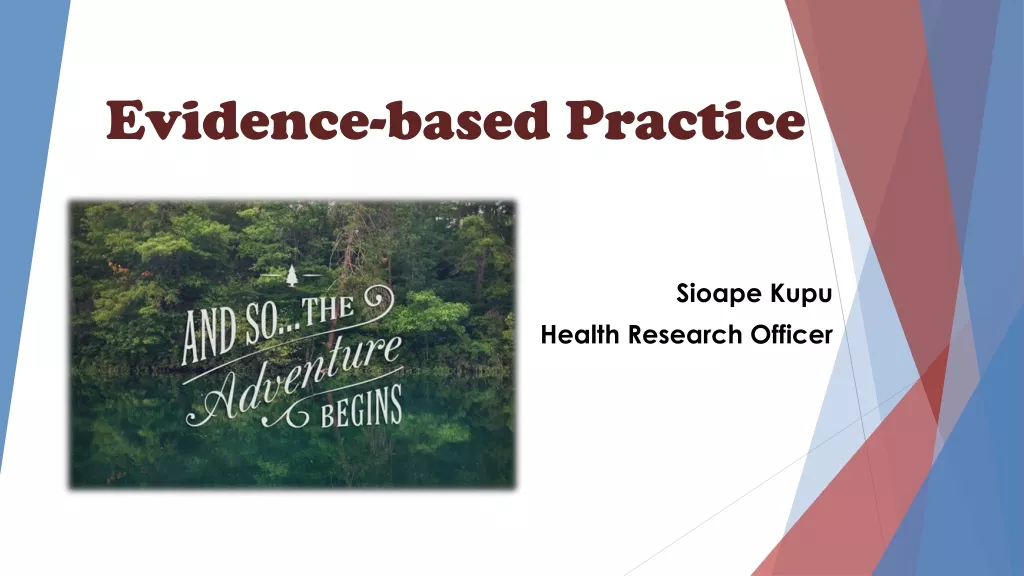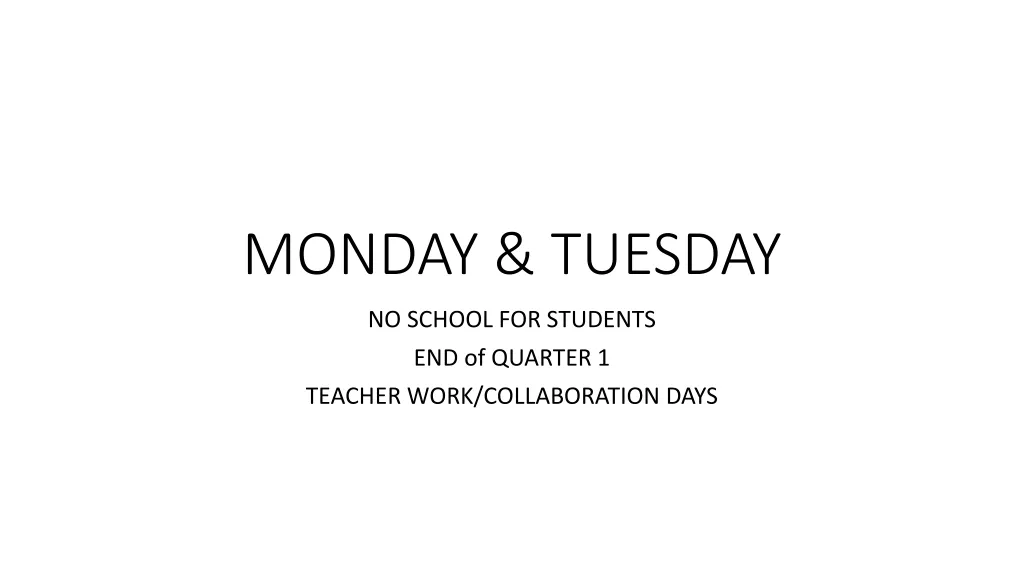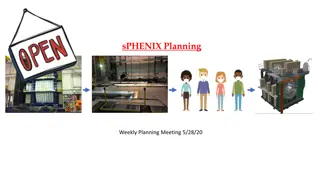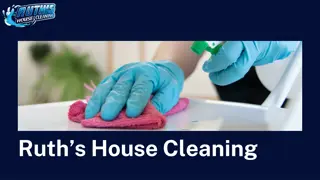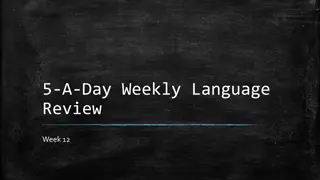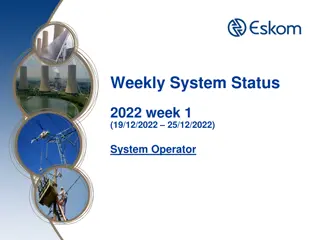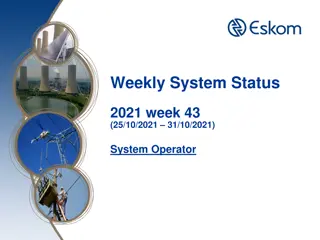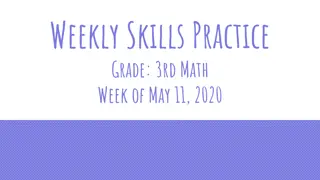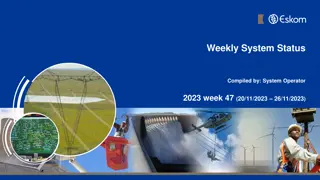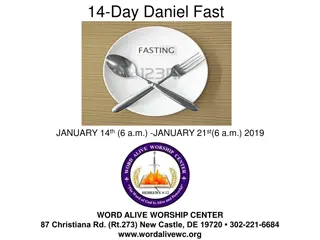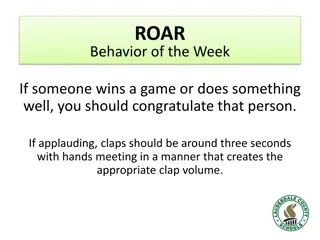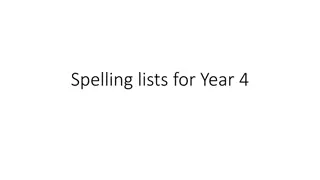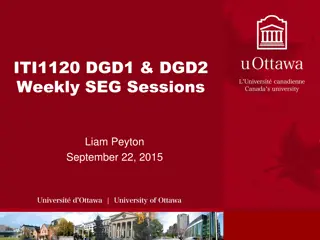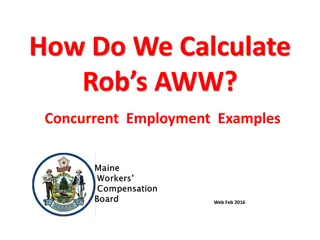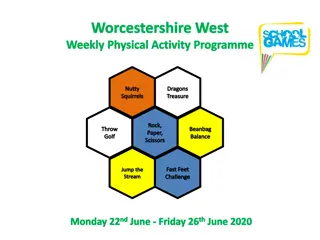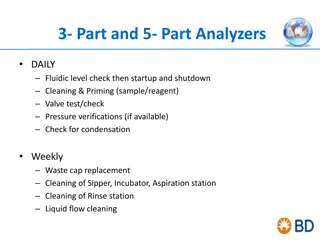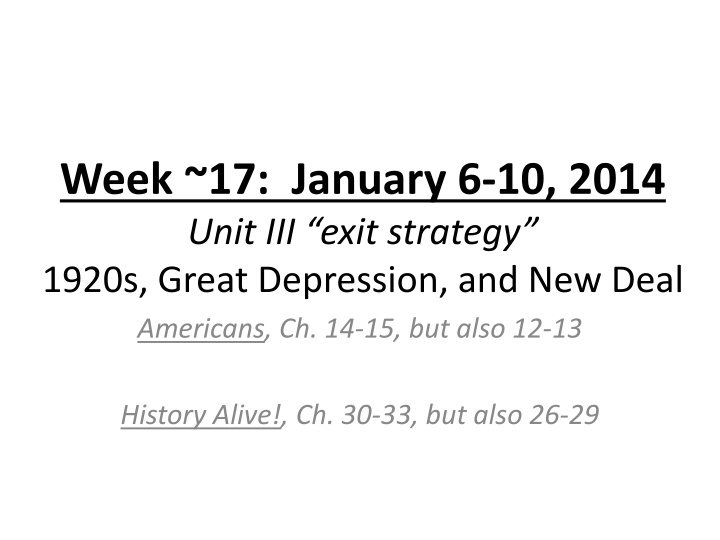
Exit Strategy: 1920s, Great Depression, and New Deal in America
Explore the historical period of the 1920s, Great Depression, and New Deal in America through assigned readings and assignments, including discussions on key events, people, and developments. Students are tasked with completing chapter summaries and participating in related activities as part of their learning.
Download Presentation

Please find below an Image/Link to download the presentation.
The content on the website is provided AS IS for your information and personal use only. It may not be sold, licensed, or shared on other websites without obtaining consent from the author. If you encounter any issues during the download, it is possible that the publisher has removed the file from their server.
You are allowed to download the files provided on this website for personal or commercial use, subject to the condition that they are used lawfully. All files are the property of their respective owners.
The content on the website is provided AS IS for your information and personal use only. It may not be sold, licensed, or shared on other websites without obtaining consent from the author.
E N D
Presentation Transcript
Week ~17: January 6-10, 2014 Unit III exit strategy 1920s, Great Depression, and New Deal Americans, Ch. 14-15, but also 12-13 History Alive!, Ch. 30-33, but also 26-29
Homework: READ your Americans chapter (12, 13, 14, or 15) & fill the front and half of the back with facts, vocab, events, people, IMAGES, etc. by Wed. 1/8 *Complete Ch. 14 & 15 ttt and Alive! summaries 30-33 by tomorrow if not completed Monday, January 6, 2014 I. Conversation Piece Pop Quiz 2013 in Review 10 participation points ++ II. Social Studies Business Sacco & Vanzetti s & Lowell Committee Letter (35 major pts) Chapter assignments (Americans 12-15) Ch. 14-15 ttt, 30-33 completed? (15 pts. each) http://upload.wikimedia.org/wikipedia/commons/6/63/Sacco_e_Vanzetti.PNG
Why are we here TODAY? http://scm-l3.technorati.com/12/12/14/73875/Brain-and--thought.jpg?t=20121214112344 http://www.hku.hk/socsc/cosc/images/objective.jpg http://flag-wallpapers.com/bulkupload/flagwallpapers/America/eagle-american.jpg Students will complete a 2013 review quiz for participation points as part of Conversation Piece, while Lowell Committee letters (35 pts) are returned, chapter assignments are given as part of the Unit III exit strategy, and lastly, Ch. 14 & 15 telescoping the times & Alive! summaries are inspected for early completion.
Conversation Piece Weekly warm-up after weekend so we can have a wonderful year A) a recent news event worthy of discussion OR B) a personal experience worth sharing OR C) a fact, quote, or this day in history event -a handout will be provided to start the conversation IF necessary! 5 minutes THINK what if I am picked to share?
NAMES: 10 points 1/6/1912 : What state became the 47th U.S. state? 1/6/1931 : True or False: Thomas Edison executed his last patent application. T or F? If TRUE, what was it for? If FALSE, when did he die? 1/6/1945 : What famous World War II battle ended with 130,000 German and 77,000 Allied casualties? Mosquitoes are attracted to what color twice as much as any other color? The venom in a Daddy Long-Legs spider is more poisonous than a Black Widow's or a Brown Recluse, but they cannot bite humans because their jaws won't open wide enough. T or F? Goofy had a wife, Mrs. Goofy, and one son what was his son s name? During a typical human life span, the heart will beat approximately billion times. percent of success is showing up. - James Allen
2013 Year in Review Pop Quiz Top U.S. News Stories 1. What Dust Bowl state experienced a monster tornado on May 21? 2. What National Security Agency contractor fled the country after revealing that NSA surveillance included massive amounts of phone records & emails of average citizens? 3. What was the name of the community watch volunteer acquitted of second-degree murder by a six-woman jury in Seminole Country, Florida? 4. What April event was rocked by deadly bombs planted by two brothers, resulting in a massive manhunt? 5. What happened on October 1 when the House & Senate could not agree on a spending bill? Top World Stories 6. What did Pope Benedict XVI do in February and how did it affect Jorge Mario Bergoglio? 7. Name at least one of the two Middle Eastern nations plagued by war or upheaval that caught headlines during the summer. 8. Where did one of the strongest typhoons ever to make landfall kill over 6,000 people in November? 9. Where is Malala Yousafzai from? 10.What is the name of the royal baby, who is third in line to become king of England? 11. BONUS: What was the most exciting, fun, or weird thing that someone in your group did over winter break?
Homework: READ your Americans chapter (12, 13, 14, or 15) & fill the front and half of the back with facts, vocab, events, people, 2+ debatable or discussion questions, IMAGES, etc. Tuesday, January 7, 2014 I. Review Program Planning Options for 10th Grade What SS course level is right for you next year? II. Complete SS Business INSPECT Ch. 14-15 ttt, 30-33 summaries (15 pts. each pair ) Pop Quiz 2013 RESULTS (10 participation points +) Sacco & Vanzetti s & Lowell Committee Letter (35 major pts) III. Unit III peer teaching & Socratic seminar expectations (Americans Ch. 12-15) individual & collaborative quizzes
Why are we here TODAY? http://scm-l3.technorati.com/12/12/14/73875/Brain-and--thought.jpg?t=20121214112344 http://www.hku.hk/socsc/cosc/images/objective.jpg http://flag-wallpapers.com/bulkupload/flagwallpapers/America/eagle-american.jpg Students will examine options for 10th grade social studies, then display Ch. 14 & 15 ttt & Alive! summaries (15 pts. for each); review of 2013 conversation piece quiz (10 pts), plus remaining Sacco & Vanzetti essays (35 major pts); overview of Unit III peer teaching & Socratic seminar expectations.
Unit III Packet #2: Ch. 14 & 15 "ttt" questions, plus the Alive! Chapters 30-33 summaries (15 pts X 2) 10 points for each ttt, 5 points for two chapter summaries. e.g. Ch. 14, plus 30 & 31 = 15! Complete BOTH chapters and EARN two, 15-point minor grades. Ch. 30 (p. 382-391) The Causes of the Great Depression Ch. 31 (p. 392-399) The Response to the Economic Collapse Ch. 14 (p. 462-485) The Great Depression Ch. 15 (p. 486-523) The New Deal Ch. 32 (p. 400-411) Human Impact of the Great Depression Ch. 33 (p. 412-427) The New Deal and its Legacy
1/6/1912 : New Mexico became the 47th U.S. state. 1/6/1931 : True or False: Thomas Edison executed his last patent application. If TRUE, what was it for? If FALSE, when did he die? http://famousdaily.com/history/thomas-edison-submits-his-last.html 1/6/1945 : The well-known World War II Battle of the Bulge ended with 130,000 German and 77,000 Allied casualties. Mosquitoes are attracted to the color blue twice as much as any other color. The venom in a Daddy Long-Legs spider is more poisonous than a Black Widow's or a Brown Recluse, but they cannot bite humans because their jaws won't open wide enough. FALSE http://spiders.ucr.edu/daddylonglegs.html Goofy had a wife, Mrs. Goofy, and one son: Maximillian Goof, Max, or Maxie or Goofy jr. During a typical human life span, the human heart will beat approximately 2.5 billion times. Eighty (80%) percent of success is showing up. - James Allen
2013 Year in Review Pop Quiz Top U.S. News Stories 1. What Dust Bowl state experienced a monster tornado on May 21? OKLAHOMA 2. What National Security Agency contractor fled the country after revealing that NSA surveillance included massive amounts of phone records & emails of average citizens? EDWARD SNOWDEN 3. What was the name of the community watch volunteer acquitted of second-degree murder by a six-woman jury in Seminole Country, Florida? GEORGE ZIMMERMAN 4. What April event was rocked by deadly bombs planted by two brothers, resulting in a massive manhunt? BOSTON MARATHON 5. What happened on October 1 when the House & Senate could not agree on a spending bill? GOVERNMENT SHUTDOWN
2013 Year in Review Pop Quiz Top World Stories 6. What did Pope Benedict XVI do in February and how did it affect Jorge Mario Bergoglio? RESIGNED POPE FRANCIS (1/2 FOR EACH PART) 7. Name at least one of the two Middle Eastern nations plagued by war or upheaval that caught headlines during the summer. SYRIA OR EGYPT (2 PTS IF BOTH) 8. Where did one of the strongest typhoons ever to make landfall kill over 6,000 people in November? PHILIPPINES 9. Where is Malala Yousafzai from? PAKISTAN 10. What is the name of the royal baby, who is third in line to become king of England? GEORGE
http://upload.wikimedia.org/wikipedia/commons/6/63/Sacco_e_Vanzetti.PNGhttp://upload.wikimedia.org/wikipedia/commons/6/63/Sacco_e_Vanzetti.PNG Your verdict? = 1-paragraph Essay RUBRIC Write a paragraph to submit to Governor Alvan Fuller and the Lowell Committee. Choose one founding ideal and describe whether it was advanced or restricted during the postwar period. Explain how the advancement or restriction of this ideal may have helped or hurt Sacco and Vanzetti in their trial. Persuasion: Write passionately about the American ideal and use the Sacco and Vanzetti trial facts & details to voice your OPINION to Governor Fuller & the Lowell Committee. Adv. (9-10) : extremely convincing arguments & evidence; committee was clearly right or wrong Prof. (7-8): somewhat convincing arguments & evidence; committee questioned (may be right or wrong) Basic (6 or less): minimal arguments and/or evidence; little attempt to address the committee (may lack awareness of task) Historical Content: Utilize the trial & hearing facts and details to support your view and explain the impact on your selected American ideal. Adv. (15-13.5) : precise details utilized effectively to evaluate impact on selected American ideal and Sacco & Vanzetti legal case Prof. (13-10.5): adequate details utilized to evaluate the impact on selected American ideal and Sacco & Vanzetti legal case Basic (10 or less): minimal details improperly used to evaluate the impact on selected American ideal and Sacco & Vanzetti legal case Conventions/Details: Write clearly using proper spelling, grammar, sentence structure (1-pg. max.), plus VISUAL. Adv. (9-10) : excellent writing with few or no errors; well-developed 1-page paragraph and appropriate picture(s) Prof. (7-8): effective writing with minor errors; 1-page paragraph and/or picture NOT exemplary (may be missing) Basic (6 or less): largely ineffective writing with many errors; minimally-developed paragraph; picture is inappropriate or missing a clear thesis that states your position? an explanation of how each piece of evidence supports your topic sentence? America s Founding Ideals: equality, rights, liberty, opportunity, democracy two pieces of evidence that support your topic sentence?
Homework: Prepare to co-teach your chapter to a group of classmates (Re-read chapter, ttt, practice speaking about essentials ) Wednesday, January 8, 2014 Unit III peer teaching WORK Time Americans: Ch. 12 & 13 teach tomorrow; 14 & 15 Friday Lab 237 10th Grade Social Studies Course Selection What SS course level is right for you next year?
Why are we here TODAY? http://scm-l3.technorati.com/12/12/14/73875/Brain-and--thought.jpg?t=20121214112344 http://www.hku.hk/socsc/cosc/images/objective.jpg http://flag-wallpapers.com/bulkupload/flagwallpapers/America/eagle-american.jpg Students will request & teacher will recommend a 10th grade social studies class; inspection of completed chapter index card, followed by preparation for peer teaching & Socratic seminar expectations.
1111 Honors Modern World History 1120 Academic Modern World History (18 weeks, 1 credit) This course will concentrate on the history of the modern world, both Western and non-Western, from 1450 CE to the present. Topics will include foreign policy, political systems, social and cultural change, and economic trends. The honors course addresses the same time period and topics but in more depth, with added readings, writing assignments, and projects. Honors weighted-grade for 1111 Honors prerequisite: Teacher recommendation.
Grade 10 Social Studies 1101 Advanced Placement European History (27 weeks, 1.5 credits) This course investigates the development of Western European society between 1450 and the present. The students will become familiar with the principal themes in modern European history and the methods for the analysis of historical evidence. Students who take this course should plan to take the Advanced Placement European History Test given in May. AP weighted-grade course. Prerequisites: B or better in 9th Advanced United States History, or A- or better in 9th Academic United States History, or teacher recommendation.
What Social Studies course should I take in tenth grade? What s the difference? In Academic Modern World History (MWH-A): In class Teacher will provide outlines that students can print off and complete. PowerPoints thoroughly explain topics. Slower pace with many checks for comprehension. One-page primary sources with academic-level questions and guided activities. For homework, expect 3-6 page reading out of academic level textbook 2-3 times per week, usually with guided notes supplied by teacher. Generally notes are collected, and may be used on open-note quizzes. For unit tests Students will receive a study guide, tests will be mostly teacher-created, tailored to material from the class, with minimally confusing distractors. 2-3 short answer and essay with graphic organizer for essay. Sample question: Who was the leader of Germany when World War II began? In Honors Modern World History (MWH-H): In class - Students will be expected to take notes that go along with their reading from the night before. Quicker pace than academic, less explanation, more discussion. PowerPoints minimally explain topics; students must listen and copy notes. Longer primary sources with more conceptual questions, fewer questions straight from the text. For homework, expect a 3-6 page reading from academic level textbook almost every night, with other readings/Quia quizzes on other nights. Students will read and take notes. Accountability is usually in form of open-note quiz. Notes are not collected or graded. For unit tests Students will receive a study guide (paper or electronic format), tests mostly teacher-created, with material specifically covered in class but also material mentioned more specifically in homework. Expect higher-level multiple choice questions. Expect closer distractors on multiple choice tests, 3-4 short answers and an essay. Sample question: Which of the following best represents the idea that technology can change cultures and economies over time? In Advanced Placement European History (AP Euro): In class - Students expected to take notes that go along with their reading from the night before. PowerPoints have sparse words, mostly visuals, just enough to prompt discussion. Very fast pace, more discussion than explanation. Longer/more primary documents for reading and discussion purposes. For homework, expect 5-10 pages of college-level textbook reading every night. The only accountability is open-note quizzes. For unit tests Students will be tested using AP level multiple choice (often from previous exams), free response essays or document-based questions (DBQs). Try the same assignment tailored to each class! Go to: http://cbweaver.wikispaces.com/Samples
Chapter Summary INDEX CARD: The Roaring 20s, The Great Depression, and the New Deal By Wednesday, FILL one side of the index card, plus half of the back as your READ The Americans TEXTBOOK: Please PRINT NAME on card! key facts: noteworthy description of people, places, events, etc. vocabulary terms: define ALL relevant words 2 or more original discussion questions: suitable for sharing in Socratic circle (debating?) Draw something small that represents the chapter The Americans Ch. 12 (p. 410-431) The Politics of the Roaring Twenties With at least one partner, you will be REVIEWING the ttt answers & main ideas for a group of classmates who did NOT specialize in your chapter, plus sharing the essentials from your index card. Timed, peer evaluated, & happening soon. Ch. 13 (p. 432-461) The Roaring Life of the 1920s Your group of resident experts will also work with History Alive! (Ch. 26-33) you will LEAD a Socratic seminar related to the focus questions (from both books) 1-2 PPT slides per person equitable division of ?s and material TEACHER & SELF-EVALUATED...happening later. ALL students will complete textbook quizzes for marking period grades (collaborative AND/OR individual), plus your own Unit III district exam! Ch. 14 (p. 462-485) The Great Depression Ch. 15 (p. 486-523) The New Deal
Unit III: 1920s, Great Depression, & New Deal PREPARE to PAIR & SHARE Ch. 12-15 1) resident expert peer groups SHARE: ADD info to index card a) Be CONFIDENT in your written answers to ttt questions & ready to EXPLAIN main ideas/locations (ttt & book) elaborate? b) Identify & discuss HOW the content connects to the EUs & EQs of Unit III 2) PAIR with an instructional partner (or two) & SHARE a) Explain answers to ttt for other chapter classmates b) most important facts (limited # of people, events, etc) c) take away ideas: explanation of main ideas, EU/EQ insights Things you should NOT do: 1) Try to teach everything! 2) WASTE time talking about other things 3) Think that this PROCESS does not matter your student peers will be evaluating you!
Homework: Prepare to co-teach chapter to classmates (Re-read chapter, ttt, practice speaking about essentials ) AND/OR begin to organize your thoughts & materials for your GROUP PPT Thursday, January 9, 2014 Ch. 12: The Politics of the Roaring Twenties Resident expert group instruction: review of ttt, main ideas index card info* Ch. 13: Life in the Roaring 1920s Resident expert group instruction: review of ttt, main ideas index card info* *Notes on index card AND Unit III EQ page =
Why are we here TODAY? http://scm-l3.technorati.com/12/12/14/73875/Brain-and--thought.jpg?t=20121214112344 http://www.hku.hk/socsc/cosc/images/objective.jpg http://flag-wallpapers.com/bulkupload/flagwallpapers/America/eagle-american.jpg Students will share & discuss the telescoping the times & main ideas related to chapters 12 & 13 via peer teaching. Some students in Periods 4-6 have index cards and/or Ch. 14 & 15 ttt work to be inspected (10 pts and 15 pts, respectively).
Chapter Summary INDEX CARD: The Roaring 20s, The Great Depression, and the New Deal Periods 4-6 (others?): FILL one side of the index card, plus half of the back as your READ The Americans TEXTBOOK NOT completed on Wednesday in all periods Please PRINT NAME on card! key facts: noteworthy description of people, places, events, etc. vocabulary terms: define ALL relevant words Per. 5 (others?): Ch. 14 & 15 ttt? 2 or more original discussion questions: suitable for sharing in Socratic circle (debating?) Draw something small that represents the chapter The Americans Ch. 12 (p. 410-431) The Politics of the Roaring Twenties With at least one partner, you will be REVIEWING the ttt answers & main ideas for a group of classmates who did NOT specialize in your chapter, plus sharing the essentials from your index card. Timed, peer evaluated, & happening soon. Ch. 13 (p. 432-461) The Roaring Life of the 1920s Your group of resident experts will also work with History Alive! (Ch. 26-33) you will LEAD a Socratic seminar related to the focus questions (from both books) 1-2 PPT slides per person equitable division of ?s and material TEACHER & SELF-EVALUATED...happening later. ALL students will complete textbook quizzes for marking period grades (collaborative AND/OR individual), plus your own Unit III district exam! Ch. 14 (p. 462-485) The Great Depression Ch. 15 (p. 486-523) The New Deal
Ch. 12: Politics of the Roaring Twenties (p. 410-431) 3. Five nations, including the United 1. Americans dislike of States, signed an agreement to dismantle parts of their in the 1920s was revealed by the . Also, 64 nations signed the Scare, by the rise of the K K - Treaty K , by a trend towards promising to give up as an instrument of ism and by laws foreign policy. limiting . 4. He made choices, which 2. The labor movement in the 1920s had some brought incidents of bribery and such as successes but mostly went into a the Scandal and Elk Hills. period of declining , in part because unions were labeled as 5. The business boom was stimulated by rise in . and by the growth of buying on .
Chapter 13:The Roaring Life of the 1920s the attempt (p. 432-461) 1. to make the sale of alcohol illegal and the 3. Through national , conflict between radio, and , the mass and science symbolized in the . media helped create a national culture. trial both reveal the clash between new and traditional values in the 1920s. 4. Among the personal achievements of the were the of Claude McKay, Langston 2. There were more work opportunities for Hughes, and Zora Neale Hurston; the of women in the 1920s than in prior years, but Paul Robeson; and the of Louis they faced Armstrong, Duke Ellington, and Bessie Smith. and unequal treatment. Women were becoming more independent and assertive. In their home lives, women more often were free to choose their own husbands, although the divorce rate . They had fewer . They enjoyed many that made housework easier.
Homework: Visit Robinsons CALENDAR and bring your IDEAS to Lab 237 for Monday s PowerPoint workday; STUDY for your chapter test Wed. 1/15 Friday, January 10, 2014 Ch. 14: The Great Depression (p. 462-485) Resident experts: summarize & review ttt, main ideas (Fill blank note sheet Peer evaluation) Ch. 15: The New Deal (p. 486-523) Resident experts: summarize & review ttt, main ideas (Fill blank note sheet Peer evaluation) *Notes on index card AND Unit III EQ page =
Why are we here TODAY? http://scm-l3.technorati.com/12/12/14/73875/Brain-and--thought.jpg?t=20121214112344 http://www.hku.hk/socsc/cosc/images/objective.jpg http://flag-wallpapers.com/bulkupload/flagwallpapers/America/eagle-american.jpg Students will share & discuss the telescoping the times & main ideas related to chapters 14 (Great Depression) & 15 (New Deal) via peer teaching. Some students have index cards and/or Ch. 14 & 15 ttt work to be inspected (10 pts and 15 pts, respectively).
Unit III: 1920s, Great Depression, & New Deal PREPARE to PAIR & SHARE Ch. 12-15 1) resident expert peer groups SHARE: ADD info to index card Be CONFIDENT in your written answers to ttt questions & ready to EXPLAIN main ideas/locations (ttt & book) elaborate? 2) PAIR with an instructional partner (or two) & SHARE a) Explainanswers to ttt for other chapter classmates b) most important facts (limited # of people, events, etc) c) take away ideas: explanation of main ideas, EU/EQ insights FASTER MORE BETTER .? Things you should NOT do: 1) Try to teach everything! 2) WASTE time talking about other things LESS ? 3) Think that this PROCESS does not matter your student peers will be evaluating you!
Chapter #: Date of instruction: Resident Expert Name: Per. # Teaching students list your FULL NAME & Date Was s/he knowledgeable & informative? YES SOMEWHAT KNOWLEDGABLE NO Non-teaching classmates complete peer evaluations based on the teachers performance. Did s/he communicate well verbally? YES SOMEWHAT NO Return to Mr. Robinson, NOT the resident experts. Did s/he show evidence of effort & care? YES SOMEWHAT NO Did s/he do a decent job teaching you? YES SOMEWHAT DECENT NO Other feedback & constructive comments: (CIRCLE ONE) 5 = excellent 4 = very good 3 = acceptable 2 = not effective 1 =no effort
Ch. 12: Politics of the Roaring Twenties (p. 432-461) 3. Five nations, including the United States, signed an agreement to dismantle parts of their navies. Also, 64 nations signed the Kellogg-Briand Treaty promising to give up war as an instrument of foreign policy. 1. Americans dislike of foreigners in the 1920s was revealed by the Red Scare, by the rise of the Ku Klux Klan, by a trend towards isolationism and by laws limiting immigration. 4. He made poor choices, which brought incidents of bribery and corruption such as the Teapot Dome Scandal and Elk Hills. 2. The labor movement in the 1920s had some successes but mostly went into a period of declining membership, in part because unions were labeled as radicals. 5. The business boom was stimulated by rise in productivity and by the growth of buying on credit.
Chapter 13:The Roaring Life of the 1920s (p. 432-461) 1. Prohibition the attempt to make the sale of alcohol illegal and the conflict between fundamentalism and science symbolized in the Scopes trial both reveal the clash between new and traditional values in the 1920s. 3. Through national magazines, radio, and movies, the mass media helped create a national culture. 4. Among the personal achievements of the Harlem Renaissance were the writings of Claude McKay, Langston Hughes, and Zora Neale Hurston; the acting of Paul Robeson; and the music of Louis Armstrong, Duke Ellington, and Bessie Smith. 2. There were more work opportunities for women in the 1920s than in prior years, but they faced discrimination and unequal treatment. Women were becoming more independent and assertive. In their home lives, women more often were free to choose their own husbands, although the divorce rate increased. They had fewer children. They enjoyed many conveniences that made housework easier.
Ch. 14: The Great Depression Name: (p. 462-485) 1. The Great Depression was caused by 3. Many men felt devastated by their inability to problems in some major , support their . Some left home. such as low overseas, Many women tried to find work, although they were weakness of , paid than men. Many children the problem of easy , suffered from lack of and and the distribution medical care; many were forced to get . of income. 2. People in suffered 4. At first did not greatly as one quarter of the workforce lost believe that the government should play an active role their jobs. Farmers suffered as well; in combating the Depression. While he never had the low demand kept food prices , government give aid to people, he did and many farmers lost their farms. African institute to create jobs. Americans and Hispanic Americans had a higher rate; those with jobs often had - jobs.
Ch. 14: The Great Depression 1. The Great Depression was caused by problems in some major industries such as low demand overseas, weakness of agriculture, the problem of easy credit, and the unequal distribution of income. 3. Many men felt devastated by their inability to support their families. Some left home. Many women tried to find work, although they were paid less than men. Many children suffered from lack of food and medical care; many were forced to get jobs. 2. People in cities suffered greatly as one quarter of the workforce lost their jobs. Farmers suffered as well; low demand kept food prices low, and many farmers lost their farms. African Americans and Hispanic Americans had a higher unemployment rate; those with jobs often had lower-paying jobs. 4. At first Hoover did not believe that the government should play an active role in combating the Depression. While he never had the government give direct aid to people, he did institute projects to create jobs.
3. Women played a role in the Ch. 15: The New Deal (p. 486-523) 1. In the first New Deal, President government, but still faced discrimination in the workplace. African Americans & Hispanic Americans the New Deal but did not receive support for full equality. Roosevelt tried to reform the Native Americans benefited from New Deal policies that system, help farmers by food prices, recognized their claims. Unions hire jobless workers for building and greatly in the New Deal years. work, passing the NIRA to promote growth, & created the T V 4. Hollywood and the offered popular A . entertainment and escape to millions. Serious artists and writers offered probing of American 2. In the Second New Deal, Roosevelt society or celebrated the of the people. won passage of new laws conserving Many writers & artists received to work from , providing loans, and offering New Deal programs. relief. The W P A gave jobs to 5. The New Deal the power of the federal millions of workers. Other laws set a national government. It alleviated the of millions of minimum , recognized workers Americans. It created the social security system and the right to , and created the social Tennessee Valley Authority, still around today. system.
3. Women played a greater role in the government, but still faced discrimination in the workplace. African Americans and Hispanic Americans supported the New Deal but did not receive support for full equality. Native Americans benefited from New Deal policies that recognized their land claims. Unions grew greatly in the New Deal years. Ch. 15: The New Deal 1. In the first New Deal, President Roosevelt tried to reform the banking system, helped farmers by raising food prices, hired jobless workers for building and conservation work, passed the NIRA to promote growth, and created the Tennessee Valley Authority. 4. Hollywood and the radio offered popular entertainment and escape to millions. Serious artists and writers offered probing critiques of American society or celebrated the virtues of the people. Many writers & artists received funds to work from New Deal programs. 2. In the Second New Deal, Roosevelt won passage of new laws conserving soil, providing loans, and offering mortgage relief. The Works Progress Administration gave jobs to millions of workers. Other laws set a national minimum wage, recognized workers right to organize, and created the social security system. 5. The New Deal expanded the power of the federal government. It alleviated the suffering of millions of Americans. It created the social security system and the Tennessee Valley Authority, still around today.
READINGS for Unit III: The Roaring 20s, The Great Depression, and the New Deal History Alive! The Roaring Twenties and Great Depression Unit 8: The Twenties Ch. 26 (p. 330-341) Understanding Postwar Tensions Ch. 27 (p. 342-351) The Politics of Normalcy Ch. 28 (p. 353-367) Popular Culture in the Roaring Twenties Ch. 29 (p. 369-379) Clash Between Traditionalism & Modernism Era 4, p. 326-327: The Americans Unit 4, p. 408-409: The 1920s and the Great Depression Ch. 12 (p. 410-431) The Politics of the Roaring Twenties Ch. 13 (p. 432-461) The Roaring Life of the 1920s Ch. 14 (p. 462-485) The Great Depression Unit 9: Great Depression and the New Deal Ch. 30 (p. 382-391) The Causes of the Great Depression Ch. 31 (p. 392-399) The Response to the Economic Collapse Ch. 32 (p. 400-411) Human Impact of the Great Depression Ch. 33 (p. 412-427) The New Deal and its Legacy Ch. 15 (p. 486-523) The New Deal
Most intriguing thing you re curious about or question? Most interesting new thing you learned? 12 I want to know more about Ch. 12: Politics of the Roaring Twenties (p. 410-431)
Most intriguing thing you re curious about or question? Most interesting new thing you learned? 13 I want to know more about Ch. 13: Roaring Life of the 1920s (p. 432-461)
Most intriguing thing you re curious about or question? Most interesting new thing you learned? 14 I want to know more about Ch. 14: The Great Depression (p. 462-485)
Most intriguing thing you re curious about or question? Most interesting new thing you learned? 15 I want to know more about Ch. 15: The New Deal (p. 486-523)
WEDNESDAY: Inspect Ch. 12-15 index card10 pts resident expert groups SHARE: ADD info from peers Thursday: Ch. 12: Resident expert group The Politics of the Roaring Twenties Ch. 13: Resident expert group Life in the Roaring 1920s Friday: Ch. 14: Resident expert group The Great Depression Ch. 15: Resident expert group The New Deal
Most intriguing thing you re curious about or question? Most interesting new thing you learned? I want to know more about Ch. 12: Politics of the Roaring Twenties (p. 410-431)
Unit III: 1920s, Great Depression & New Deal Socratic Circle Preparations Wednesday, 1/8; Monday & Tuesday, 1/13 & 1/14 1) After logging in & opening ROBINSON Shares file, designate a chapter captain who will SAVE the file to her/his network folder. Sample File name: JohnsonPeriod1Chapter12 2) Examine this entire PPT slide show together, then decide which slides/questions to keep, edit, or DELETE. *Opening slide required. Conclusion suggested, but not required* 3) Use flash drives, gmail and/or google.doc, Office 356, or network folders to SAVE & SHARE your contributions as you assemble a chapter-specific PPT slide show containing: 1 or 2 SLIDES per PERSON* ex. 5 people = *12 slides (opening/conclusion) included 1 or 2 open-ended discussion questions and illustrative & appropriate pictures, clip art, graphs, maps, etc BRIEF Enduring Understanding connections or insights EQ answers *Include your name on each slide! *Examine questions below TODAY and begin to assemble & arrange your slides into Johnson s file!
Unit III: 1920s, Great Depression, & New Deal Essential Questions What happens when traditional and modern cultures interact? What influences do economic excesses have on American society? What is the proper role of the government in people s lives? Did America move closer to or further away from its founding ideals during the interwar period? Enduring Understandings Cultural patterns established between the world wars are still relevant today. Conflict occurs when people perceive that traditional values and culture are threatened by modern changes. Economic excess and the unequal distributions of wealth can lead to instability in society. Liberals and Conservatives have different beliefs about individual responsibility and the proper role of the government. As a result of the New Deal, the United States government took on greater responsibilities for promoting the general welfare.
Essential Questions What happens when traditional and modern cultures interact? What influences do economic excesses have on American society? What is the proper role of the government in people s lives? Did America move closer to or further away from its founding ideals during the interwar period? What happens when traditional and modern cultures interact? The clash between traditional moral values and changing ideas were exemplified in the controversy over Prohibition, the Scopes trial, and the emergence of the New Woman. Rising tensions including, the resurgence of the Ku Klux Klan, and the rise of socialism/communism. How different forms of mass media created consumerism and mass culture. Contributions of artists and writers of the Harlem Renaissance What influences do economic excesses have on American society? Impact of the economic policies of the Harding and Coolidge administrations on wealth distribution, investment, and taxes. Basic operation of the stock market. Causes and consequences of the Great Depression and Dust Bowl. What is the proper role of the government in people s lives? Effectiveness of presidential responses of the Hoover and Roosevelt administrations. Opponents of New Deal policies and their arguments.
Unit 8: The Twenties (p. 328-380) Chapter 12 from the AMERICANS What effects did postwar tensions have on America s ideals? Did the Republican Era of the 1920s bring peace and prosperity to all Americans? Chapter 13 from the AMERICANS What social trends and innovations shaped popular culture during the 1920s? How did social, economic, and religious tensions divide Americans during the Roaring Twenties?
Unit 9: The Great Depression and the New Deal (p. 381-427) Chapter 14 from the AMERICANS What caused the most severe economic crisis in American history? How did the federal government respond to the economic collapse the began in 1929? How did ordinary Americans endure the hardships of the Great Depression? Chapter 15 from the AMERICANS How did expansion of the government during the New Deal affect the nation?
Ch. 12: The Politics of the 1920s Warren G. Harding s presidency was plagued by scandal, and it was later regarded as unsuccessful. Explain why President Harding was popular with the American public despite these facts. Think About: American attitudes and feelings after World War I Harding s appearance, personality, and promises the yearning for the simpler days before the Progressive Era and World War I What technological invention or advancement of the 1920s had the biggest impact on the life of the average American? Explain your opinion. Think About: advances in the fields of business, transportation, power, and machinery the basic needs of Americans the conveniences offered by new technology

